Open Journal of Stomatology
Vol.3 No.3(2013), Article ID:33704,4 pages DOI:10.4236/ojst.2013.33039
Maxillary subperiosteal implantitis that caused severe bone resorption of the maxilla with perforation of the maxillary sinus and sinusitis: A case report
![]()
Department of Oral and Maxillofacial Surgery, Hyogo College of Medicine, Nishinomiya, Japan
Email: *ktaka@hyo-med.ac.jp
Copyright © 2013 Kazuki Takaoka et al. This is an open access article distributed under the Creative Commons Attribution License, which permits unrestricted use, distribution, and reproduction in any medium, provided the original work is properly cited.
Received 22 April 2013; revised 22 May 2013; accepted 10 June 2013
Keywords: Subperiosteal implant; Implantitis; Sinusitis
ABSTRACT
Subperiosteal implants are generally used in the severely resorbed areas, and although dwindling in use, they have shown to be successful treatment options for the edentulous dental patients. We report a case of maxillary subperiosteal implantitis that caused sinusitis. A 59-year-old man was referred to our clinic in March 2003 with a chief complaint of pain and swelling in the bilateral upper molar region. He received a surgical operation for maxillary subperiosteal implant at another dental clinic in April 2001. CT scans demonstrated that the radiopacity of the right maxillary sinus extended to the ethmoid and frontal sinuses. Extensive surgical debridement was performed. The radiopacity of the right maxillary sinus in CT almost disappeared in a month. Two months later, the occlusal function was recovered using a new maxillary complete denture. The patient has had no symptoms and no occlusal disturbance by the denture for more than nine years.
1. INTRODUCTION
Odontogenic sinusitis is a well-recognized condition that is usually responsive to standard medical and surgical treatment. Complications in implantology related to the maxillary sinus include maxillary sinusitis or oroantral fistulae [1]. Subperiosteal implants have been applied for a reduced alveolar bone. However, many cases ended in failure, and some caused severe sinusitis and bone absorption. In the presence of infection caused by a failing subperiosteal implant, traditional antibiotic treatment may not suffice due to underlying defective hardware still being present. Immediate removal of defective hardware with debridement is recommended [2]. We report a case of subperiosteal implant that caused severe bone absorption of the maxilla with perforation of maxillary sinus that not only in maxillary but in ethmoid and frontal sinusitis.
2. CASE REPORT
A 59-year-old man was referred to our clinic in March 2003 with a chief complaint of pain and swelling in the bilateral upper molar region. He received a surgical operation for maxillary subperiosteal implant at another dental clinic in April 2001. Four months after the operation, he became aware of swelling of the left maxillary area. Two years had passed with treatment of occlusion and antibiotics at the dental clinic. The problem did not resolve in spite of these treatments. Since he had increased pain and swelling, he decided to visit us for consultation. The patient showed markedly edematous and fluctuant palatal gingiva (Figure 1). Panoramic radiography exhibited that remarkable resorption bone was observed in the area surrounding the implant framework (Figure 2). CT scans demonstrated radiopacity of the right maxillary sinus extending to the ethmoid and frontal sinuses (Figure 3). The left maxillary sinus was punctured and aspirated pus was subjected to microbial examination. As a result, α-Streptococcus was detected. From these findings the clinical diagnosis was sinusitis caused by subperiosteal implantitis. The subperiosteal implant was removed by the mucoperiosteal flap preparation under the general anesthesia in May 2003. Diffuse purulent exudate and massive granulation tissues were observed in the surrounding area of the framework, which was visualized and released from the engulfing granulomatous and fibrous connective tissues using sharp dissection (Figure 4). After removal

Figure 1. Clinical photograph showing diffuse swelling on the palate.

Figure 2. Panoramic radiography at initial examination. Bone absorption (arrow) was observed in the area surrounding the implant framework.
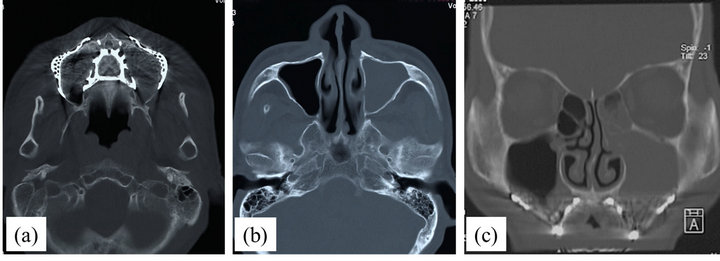
Figure 3. CT scan shows opacification of the right maxillary and ethmoid sinuses. (a), (b) Axial view; (c) Coronal view.
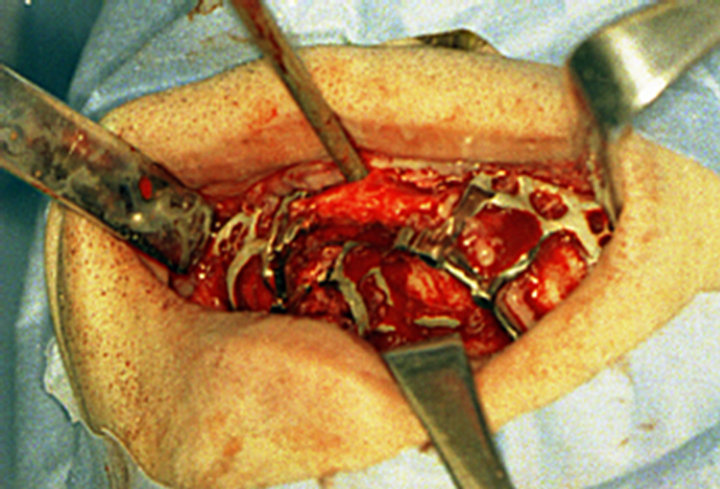
Figure 4. Intraoperative view which shows the subperiosteal implant framework was visualized.
of the framework, large bone defects were seen on both sides (Figure 5). The sinus was accessed through the bone defect in the left side. The sinus mucosa was thickened, and the sinus was filed with mucopurulent exudate. Extensive surgical debridement was performed. The oroantral fistula was closed with by conventional pedicled palatal flap (also known as palatal rotation advancement flap). The flap was extending anterior and large enough with the base of the pedicle over the greater palatine foramen (Figure 6). Antibiotics and nonsteroidal anti-inflammatory drugs were administered before and after surgical treatment. The radiopacity of the left maxillary sinus in CT almost disappeared in a month by continuing administration of Clarithromicin (200 mg/ day) after the operation (Figure 7). Two months later, the occlusal function was recovered using a new maxillary complete denture. Post-operative CT after four years showed no mucosal thickening within the maxillary sinuses (Figure 8). The patient has had no symptoms and no occlusal disturbance by the denture for more than nine years (Figure 9).
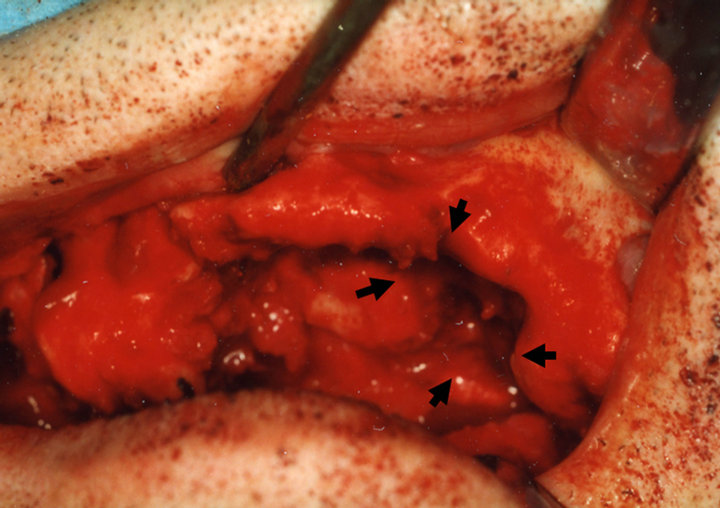
Figure 5. Intraoperative view which shows large bone defects were seen on both sides. The bone defect (arrow) was approximately 13 mm × 20 mm on the left side.
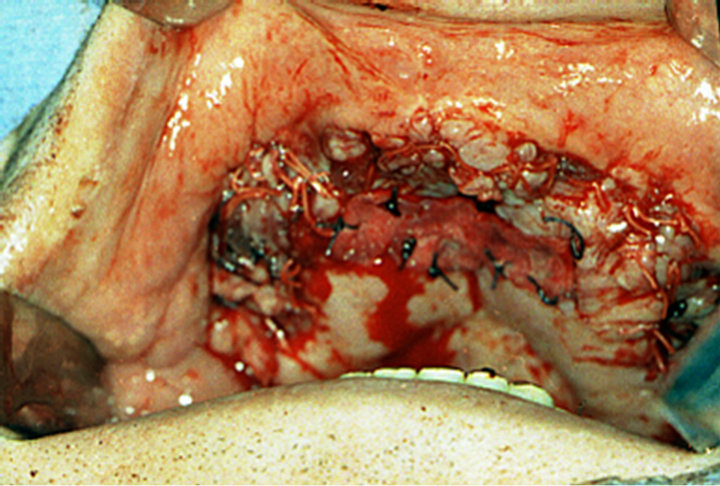
Figure 6. The bone defect was closed with by conventional pedicled palatal flap.
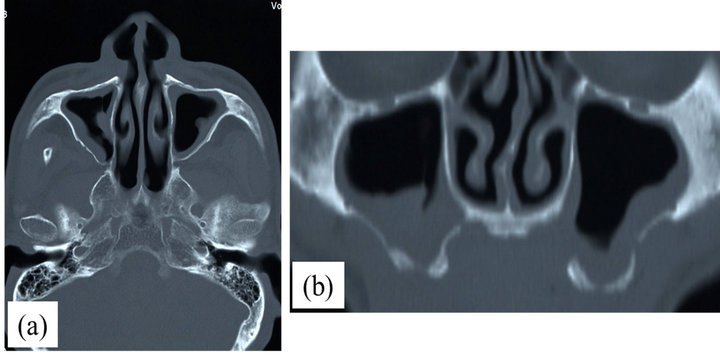
Figure 7. CT scan shows the radiopacity of the left maxillary sinus almost disappeared a month after the surgery. (a) Axial view. (b) Coronal view.
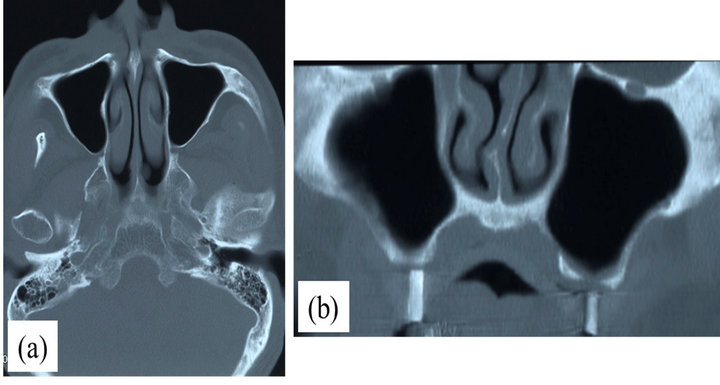
Figure 8. CT scan shows no mucosal thickening within the maxillary sinuses. (a) Axial view. (b) Coronal view.

Figure 9. The maxillary full denture provided function. (a) An intraoral view. (b) A frontal face view after placement of maxillary prosthesis.
3. DISCUSSION
Mandibular subperiosteal implants were first used in the 1940s by Dahl [3]. Many improvements have been made, and clinical applications have been performed actively since the 1950s. The subperiosteal implants are generally used in the severely resorbed areas [4], and although dwindling in use, have shown to be a successful treatment option for the edentulous dental patient. The maxilla was uniformly less successful as a location than the mandibule [2]. Designing a subperiosteal implant that rests on dense cortical bone rather than on cancellous alveolar bone is more difficult to achieve in the maxillary arch than in the mandibular arch. The larger and heavier the implant, the more it is affected by gravity—a particularly important consideration in maxilla [5]. Failing maxillary substeal implants might cause severe bone absorption. Severely absorbed maxilla of our patient had large bone defect in the molar region. We could analyzed identification of regional expansion by standard and computed tomography. We recommend immediate removal of a failing subperiosteal implant with debridement. Following subperiosteal implant removal, reconstruction procedures are extremely difficult due to the extensive resorption and the adverse soft tissue changes of the alveolar ridge. After removal of sources of infection, oroantral communication should be treated by establishing a physical barrier between oral cavity and maxillary sinus, and numerous surgical rotating or advancing local tissues such as the buccal or palatal mucosa, buccal fat pad, submucosal tissue, or tongue [6].
4. CONCLUSION
We described a case of maxillary subperiosteal implantitis that caused severe sinusitis and bone absorption. The defective hardware was subsequently removed, which resulted in alleviation of the patient’s symptom.
REFERENCES
- Regev, E., Smith, R.A., Perrott, D.H. and Pogrel, M.A. (1995) Maxillary sinus complications related to endosseous implants. The International Journal of Oral & Maxillofacial Implants, 10, 451-461.
- Markiewics, M.R., Nishiyama, K., Yago, K. and Okada, M. (2007) Draining Orocutaneous fistula associated with a failing subperiosteal implant: Report of a case. Journal of Oral Implantology, 33, 347-352. doi:10.1563/1548-1336(2007)33[347:DOFAWA]2.0.CO;2
- Dahl, G. (1943) Om möjlighten ör inplantation I käken av metallskelett som bas eller retention ör fasta eller avtagbara protester. Odontologisk Tidskrift, 51, 440-449.
- O’Roark, W.L. (1997) Survival rate of dental implants: An individual practitioner’s anecdotal review of 25 years of experience. Journal of Oral Implantology, 23, 90-103.
- Linkow, L.I. and Ghalili, R. (1998) Critical design errors in maxillary subperiosteal implants. Journal of Oral Implantology, 24, 198-205. doi:10.1563/1548-1336(1998)024<0198:CDEIMS>2.3.CO;2
- Scattarella, A., Ballini, A., Grassi, F.R., et al. (2010) Treatment of oroantral fistula with autologous bone graft and application of a non-reabsorbable membrane. International Journal of Medical Sciences, 11, 267-271. doi:10.7150/ijms.7.267
NOTES
*Corresponding author.

